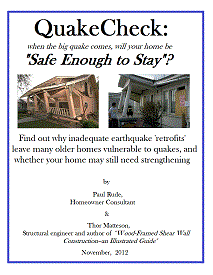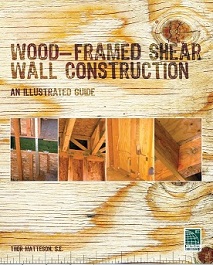
Order the Shear Wall Guide from the International Code Council
International Code Council (ICC) Publications
The International Existing Building Code (IEBC). The IEBC may be available for free viewing on the web somewhere, but it is not easy to find. The IEBC is almost identical to the California Existing Building Code which is available for free viewing (see below under "Standard Plans").Order the IEBC directly from the ICC website
“Wood-Framed Shear Wall Construction—an Illustrated Guide” (SECOND EDITION)
ICC Publication #4020S09 Order the Shear Wall Construction Guide directly from the ICC website. Cover is shown at left, second from top.
The second edition of the Shear Wall Construction Guide is 180 pages long, with over 150 illustrations and photos. Chapter 6 introduces residential earthquake retrofits.
The Shear Wall Construction Guide addresses many field conditions and obstacles encountered in shear wall construction. It also includes information on collectors, openings through shear walls, wood shrinkage, and other topics related to new or retrofit construction.
Both of the above publications are also available from Builders Booksource in Berkeley: 1817 4th St., Berkeley, CA 94710 (510) 845-6874
US Federal Emergency Management Agency (FEMA) documents
FEMA P-593 Seismic Rehabilitation Training for One- and Two-Family Wood-Frame Dwellings--2008Features a very useful color-coded chart showing common hazards to look for; chart gives references of where to find more info (many of which are listed here). Current format is essentially Power Point slides; this is a good review if you attended the seminar, but without accompanying discussion it is unlikely a reader will learn retrofit methods by reading the materials alone. Contains good examples of some common mis-applications of hardware to avoid.
FEMA P-547 Techniques for the Seismic Rehabilitation of Existing Buildings--2006
An expansion of prior FEMA documents, especially with respect to wood-framed buildings. Chapter 5 applies to residential construction. This is the first FEMA (or related) publication I have seen that includes information on how to retrofit "balloon framing." The link above is for Part 1 (containing Chapter 5).
FEMA P 50-1 "Seismic rehabilitation guidelines for detached, single-family wood-framed buildings" (Chapter 2 only).
Chapter 2 of FEMA P 50-1 shows limited installation methods for residential earthquake retrofits. The information presented is mostly the same as found in FEMA P-547. As of November, 2012, FEMA P-50-1 is not readily available on the Web; this PDF of Chapter 2 is provided at www.quakecheck.org as a public service.
"Standard" Earthquake Retrofit Plans
Note: All of the "standard" plans have limited applicability
The Association of Bay Area Governments' Standard Plan A (commonly called "Plan Set A") has the following limitations:
- One or two family dwellings
- Less than three stories
- Wood framed
- Continuous perimeter foundation
- Houses built over a crawlspace
- Cripple walls cannot be more than 4 feet tall
- May not have exterior brick or stone facing more than 4 feet tall
- Limits on some types of heavy tile roofing
The following “standard plans” are either identical to, or minor variations on, information presented in the International Existing Building Code (IEBC). The IEBC is based on early recommendations from FEMA.
- California Existing Building Code, Appendix Chapter A3 Essentially identical to the IEBC. This is the free version of the code, in a format intended to annoy you into buying the print copy.
- ABAG—"Standard Plan A" (usually called "Plan Set A") (PDF, 24" x 36" format) Consists of two full-size 24” x 36” drawing sheets.
The instructions for determining whether you can use Plan Set A for a particular house are somewhat confusing. Follow this link for a detailed explanation of Plan Set A requirements and limitations
More information on Plan Set A is available at: http://www.abag.ca.gov/bayarea/eqmaps/fixit/plansets.html - City of Seattle—Project Impact (PDF, 11” x 17” format)
There is also a workbook that accompanies the plan set, which expands somewhat on how to implement work under its requirements - LA—Standard Plan No. 1 (PDF, 30” x 40" format)
To order by phone, in case you don't have a printer that will print 30" x 40" sheets: call the LA Department of Building and Safety Customer Call Center at 888-LA4BUILD (888-524-2845) for calls originating inside of Los Angeles County. For calls originating outside of Los Angeles County, call (213) 482-0000
Limitations for Los Angeles "Standard Plan One"
US Geological Survey publications
Various regional guides published jointly with local agencies. Overview of seismology, shaking maps, fault locations, emergency preparations. Customized for several regions.As of November, 2012, they all show the wrong direction to turn a gas supply valve to close it (although many gas shut-off valves can be turned either way, some cannot; check yours before the quake).
- Putting Down Roots in Earthquake Country--Northern California (PDF, 5.5 MB) or HTML version
- Putting Down Roots in Earthquake Country--Southern California (PDF, 8.2 MB)
- Living with Earthquakes in Nevada (PDF, 8 MB)
- Putting Down Roots in Earthquake Country--Utah (PDF, 8.6 MB) A higher-resolution version is also available at . Also available in high-resolution (54 MB) from the Utah Seismic Safety Commission
- Putting Down Roots in Earthquake Country--Central US (PDF, 25 MB) Read about the New Madrid Earthquake starting on page 4.
Other resources
Note: Print these out or become familiar with them BEFORE the power goes off in a disaster.
"Food and Water in an Emergency" PDF (FEMA)
Shopping list of Emergency Supplies, from the American Red Cross--suggested 5-week plan for assembling emergency supplies and equipment (or here)
Methods to secure the contents of your home, by the Association of Bay Area Governments
5-minute VIDEO of how to properly brace a water heater, produced by the Golden Gate Chapter of the American Society of Home Inspectors
List of certified automatic gas shut-off valves (the State of California may still certify automatic shut-off valves; this list was last updated in 2008, and is no longer found on the state website.)
Books
"Surviving in Earthquake Country"—by Peter Yanev, Structural Engineer
New edition released in 2010 or so. Excellent overview of geologic considerations, behavior of various high-rise and commercial building types, and residential hazards (such as hillside homes) to look for. Mr. Yanev has decades of experience in analyzing earthquake risks and designing strengthening measures for all kinds of facilities and buildings. This book illustrates basic residential retrofit measures similar to those in other publications listed above.
